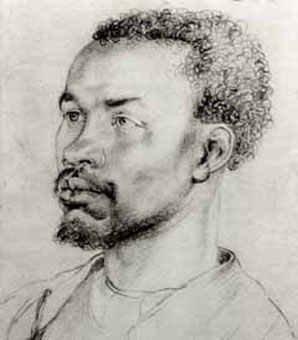There's another picture,purportedly of the same man. IMO,the dress is too modern to be of the 1600s. Anyway there are deeper matters to be looked into.
New info has come to light. Whether or not either is an accurate reproduction of America's first known slave holder there are certain inconsistencies in the official history wherein he's referred to as an ex Angolan slave.The trouble is according to the same accepted sources, during the 1600s Angola's slaves were overwhelmingly destined for Brazil,the Caribbean,Europe and S.E Latin America. The implications are as unbelievable to a history student as they are obvious to the real researcher.
It is increasingly likely he was one of the losing Black Catholic survivors of the 30 years war that embroiled the whole of Europe in the mid 1600s. (Yes,there were European blacks from as far back as the Neolithic era even beyond circa 40,000 bc settled as far as the Caucus mountains in S.Russia. Nowadays they're referred to as slaves and/or freedmen but they always existed and were part and parcel of Europe.) This war from 1620-1650 began in modern day Germany,the Holy Roman Empire between adherents of the new Protestant faith and followers of traditional Catholicism,many of whom were among the original black Europeans.
Returning to Anthony,his son later owned eleven Irish slaves. By 1700 there were 6000 white and 2000 black slaves.The transatlantic crossing was even worse than that of black slaves. Here's an excerpt from a German immigrant diary in the 1750s.
Children from one to seven years rarely survive the voyage; and many a time parents are compelled to see their children miserably suffer and die from hunger, thirst, and sickness, and then to see them cast into the water. I witnessed such misery in no less than thirty-two children in our ship, all of whom were thrown into the sea. The parents grieve all the more since their children find no resting place in the earth, but are devoured by the monsters of the sea. It is a notable fact that children who have not yet had the measles or smallpox generally get them on board the ship, and mostly die of them.http://www.saveyourheritage.com/slavery.htm
Early slave holding patterns continued and by the civil war blacks were actually larger slave owners per capita than whites.According to the U.S. census report for that last year before the Civil War, there were nearly 27 million whites in the country. Some eight million of them lived in the slaveholding states.
The census also determined that there were fewer than 400,000 individuals who owned slaves . Even if all slaveholders had been white, that would amount to only 1.4 percent of whites in the country (or 4.8 percent of southern whites owning one or more slaves). In fact Duke University professor professor John Hope Franklin, records that in New Orleans over 3,000 free Negroes owned slaves, or 28 percent of the free Negroes in that city.
Despite decades of Hollywood Mandingo/Roots type propaganda both black and white masters shared the same conditions with their charges; be it in house, helping planting in the field or workshop carpentry & ironmongery ,and owned between 1 and 5 slaves. The few individuals who owned 50 or more slaves were confined to the top one percent, and have been defined as slave magnates.
Of this small subset there was a significant number of blacks including 6 in Louisiana ,the largest of them the widow C. Richards and her son P.C. Richards, who owned a large sugar cane plantation. who possessed over 150. The non racial pattern of slave owning was part of a socioeconomic system that allowed blacks upward mobility in slave owning America-it was such a successful system 65,000 blacks volunteered and fought for Confederate forces.
"When you eliminate the black Confederate
soldier, you've eliminated the history of the South." quoted from
General Robert E. Lee, in 1864.
n late August 1868, General Nathan Bedford Forrest gave an interview to a reporter. Forrest said of the black men who served with him:
The Caribbean had many numbers of Irish slaves. Jamaica was typical. "Surplus poor," and hated Catholics were considered "inside out niggers" and 80% didn't survive their first year on the cane fields since they were anyway undervalued compared to their black counterparts.In Trinidad Fr Anthony De Verteuil (Seven Slaves and Slavery: Trinidad 1777-1838) estimated that at least 60 per cent of the owners were coloured, and concluded "with certainty" that at least half to two-thirds of the slave-owners in Trinidad were coloured and that they owned about 20 per cent of the slaves.
Dear Reader,things are never as black and white as the guardians of history would have us believe.
http://karanjazplace.blogspot.com/2012/10/slavery-wasnt-black-thing.html




According to Bryan Sykes who wrote the book DNA USA in an interview with Dylan Ratigan the majority of southern whites have African DNA. Under the one drop racist rule they could have become slave. It looks like the southern black slave owners families became white by mixing with white people.
ReplyDeleteThough I couldn't get firm figures many of the blacks were actually indigenous Americans.
ReplyDelete